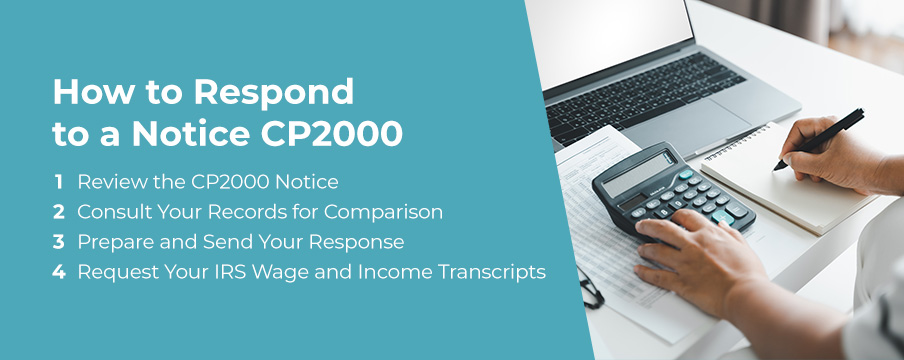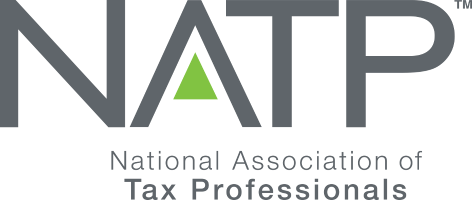
What Is IRS Notice CP2000 and How Should You Respond?
Have you received an IRS notice CP2000? Do you want to know what it means and how to respond? If yes, then you’ve come to the right place. The Internal Revenue Service (IRS) has many ways of determining a taxpayer’s tax liability. A typical example is obtaining information from third parties like employers. If the information received conflicts with the numbers on the IRS file, the IRS may send a notice CP2000. Read on to learn more about this notice and how to respond.
What Is IRS Notice CP2000?
CP2000 is a notice of underreported income or an underreporter inquiry. The IRS sends this notice to taxpayers when information on the tax return does not match the information on the IRS file. In other words, if the IRS receives income or payment information from another source, such as an employer or financial institution, which conflicts with what you reported on your tax return, the IRS may send a CP2000 notice.
A CP2000 notice is not a bill. Instead, it’s a proposal to amend the tax return due to discrepancies. The notice usually lays out the proposed adjustments with explanations. It also includes instructions on how to respond if you disagree. Taxpayers who receive an IRS notice CP2000 must carefully review the content, gather supporting documents and respond before the specified deadline. Consulting with a tax expert is a crucial step.
CP2000 notices are computer-generated, so they may be wrong. Sometimes, taxpayers receive notices although they have paid their taxes in full. A tax professional can assess your financial situation and advise you. They can also help you respond and represent you if the need arises.
Why Did You Receive Notice CP2000?
The IRS may send a notice CP2000 because there is a possible discrepancy in your tax return. Common examples include the following:
- Underreported income: You may receive a notice CP2000 if you do not report income on your tax return.
- Mismatched taxpayer information: The IRS may send a notice CP2000 if there is incorrect information on your tax return. Examples include a wrong identification number or filing status.
- Overstated deductions or credits: A notice CP2000 may stem from you claiming more credits or deductions than you’re entitled to.
The IRS compares the information on your tax return with what the third party provided. This process promotes accurate reporting of tax liabilities.
How to Respond to a Notice CP2000

The IRS includes a response form when sending a notice CP2000. They also add a payment voucher and a mailing envelope for your reply. While it’s crucial to respond on time, there are a few things to do:
1. Review the CP2000 Notice
Review the CP2000 notice carefully to understand the content. It will usually include the income, deduction or credits you reported. The IRS will also indicate the forms and amounts the third party reported under your taxpayer identification number (TIN) and propose changes. Reviewing the notice helps you determine whether the details are correct.
2. Consult Your Records for Comparison
After reviewing the notice, gather the relevant documents, such as forms W-2 or 1099. Compare them with the CP2000 notice to see if you left anything out. Calculate any additional taxes that you may owe, as well as deductions. Comparing the information helps determine whether you agree or disagree with the notice. It’s possible to agree partially.
3. Prepare and Send Your Response
Send the completed CP2000 response form to the IRS with the payment if you agree with the notice. Remember to sign and date it. If you filed a joint return, ensure your spouse signs the form. You can request a CP2000 payment plan in your response if you cannot pay the entire amount at once. The payment plan allows you to pay in installments.
If you disagree, wholly or partially, compile the relevant documents and mail them to the IRS. It’s essential to provide reasons for your disagreements. You can attach the corrected tax return to the response. However, do not file an amended tax return — the IRS will make the corrections if they accept your explanation. If there are any proposed penalties, you can address them in your response. If the IRS rejects your response, you can file an appeal.
Take note of the deadline when responding to the notice, as the IRS typically expects a response within 30 days. Noncompliance usually attracts penalties and interest. You can send the response by mail, fax or electronic means, and the notice will provide the details and instructions for doing so. The IRS may respond in four to eight weeks, and you can follow up if there is an unreasonable delay.
4. Request Your IRS Wage and Income Transcripts
Finally, request your IRS wage and income transcripts and have a tax professional analyze them. You want to ensure the IRS has resolved the issue and confirm there are no errors in the other years. It’s best to file an amended return to avoid penalties if you find any errors.
Additional Tips When Responding to a Notice CP2000
Now that you know the steps for responding to an IRS notice CP2000, let’s dive deeper into some essential considerations:
1. Filing for Extension
IRS CP2000 notices come with a deadline — usually 30 days. You may incur penalties and interest if you fail to respond before the deadline. If you need more time to respond, contact the IRS immediately. The IRS often allows a 30-day extension, but you must provide a valid reason.
2. Contesting Penalties
The IRS sometimes levies penalties with CP2000 notices. A classic example is the 20% accuracy penalty, which applies when the taxpayer is negligent or disregards the tax laws. If you disagree with the penalty, you can contest it by citing the law and relevant facts. Penalties are contestable even if you agree with the IRS proposal.
3. Requesting CP2000 Reconsideration
You can request reconsideration if the IRS disregards your response without explanation. This process asks that the IRS reassess your tax liability and make any necessary corrections. You will need to resubmit the same evidence as in your initial response and include a cover letter specifying that you’re asking for reconsideration.
4. Requesting an Appeal
Typically, you have 30 days to appeal when the IRS responds. The appeal goes to the IRS Independent Office of Appeals, a separate department responsible for resolving disputes. If you fail to respond and miss the appeal deadline, the IRS may send a notice CP3219A, which is the statutory notice of deficiency. This notice indicates that you can no longer appeal within the IRS and must file a petition in tax court instead.
5. Seeking Professional Assistance
Responding to CP2000 notices can be confusing and stressful, so it’s always wise to consult with a professional. A tax expert can assess your returns and determine whether there are discrepancies. They can also prepare a response leveraging their experience and resources. While optional, hiring a tax professional is a smart move to ensure you have everything you need to respond to the CP2000 notice and increase the likelihood of a favorable outcome.
Get Help From the Experts at BC Tax
BC Tax is a leading tax consultation agency in the United States. We have served clients in Colorado and beyond for over 20 years. Our licensed agents can provide practical solutions for cases of any complexity. Contact us now if you need professional tax assistance. We are ready to help!

 1-800-548-4639
1-800-548-4639









